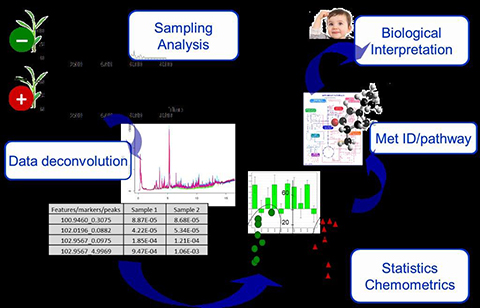Services aux académies
Le NPAC offre une gamme de solutions aux chercheurs qui souhaitent analyser des composés biologiques ou synthétiques. Les projets sont réalisés en collaboration ou sous la forme de service à des prix compétitifs (Veuillez nous contacter pour des informations sur nos conditions et prix). L’unité de spectrométrie de masse et métabolomique possède une grande expertise dans l’analyse ciblée ou non-ciblée de petites molécules dans des matrices biologiques variées
-
• Targeted metabolite analysis:
UHPLC-DAD-MS/(MS) is used for the quantification of selected compounds with high sensitivity. Standard methods routinely applied in our facility are:
- Quantification of neonicotinoids in honey, soil, plants, insects etc.
- Quantification of steroid hormones in plasma, urine, hair and water
- Quantification of phytohormones (JA, JA-Ile, OPDA, ABA, SA, IAA)
- Quantification of prenyllipids in plants (e.g. tocopherols, vitamin K, plastoquinone)
- Quantification of tocopherols in plasma
- Quantification of carotenoids in plants
- Quantification of glucosinolates in plants
- Quantification of benzoxazinones in crops (e.g. DIMBOA)
- Quantification of malondialdehyde in plasma, RBC and sperm
- Quantification of organic acids in soil
- Quantification of phenolics in plants
We also have a range of non-routine methods developed for specific applications (e.g. alkaloids, cyanogenic glycosides, iridoid glycosides, napthoquinones, some pesticides, gluthathion, bêta-aminobutyric acid) and can perform custom method development for your research needs.
-
• Untargeted metabolite analysis:
In the field of metabolomics, various analytical instruments may be employed to provide the broadest picture possible of metabolomes. At the NPAC, we use reverse phase ultra-high pressure liquid chromatography coupled to quadrupole time-of-flight mass spectrometry (UHPLC-QTOFMS) in this purpose. Generally, rapid gradients are applied for metabolite fingerprinting of complex extracts using the so-called MSE detection mode which enables the alternative acquisition of pseudo-molecular and fragment ions with high mass accuracy during a single run. Feature detection and statistical data treatment are then performed using dedicated softwares to reveal relevant markers. Compound annotation usually relies on molecular formula and fragmentation pattern information. Additionally, targeted isolation followed by NMR analysis may be performed for challenging metabolites. Scientists working at the NPAC are recognized experts in plant metabolomics (see our publication list) and are willing to take on the new challenges posed by your applications.
Figure 1: typical worflow used for untargeted metabolomics.


